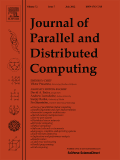
JOURNAL OF PARALLEL AND DISTRIBUTED COMPUTING
Scope & Guideline
Leading the Charge in High-Impact Computer Science Research
Introduction
Aims and Scopes
- Parallel Computing Techniques:
Research on algorithms and frameworks that enhance the performance and efficiency of parallel computing systems, including GPU acceleration, MPI, and OpenMP. - Distributed Systems and Architectures:
Studies on the design, implementation, and optimization of distributed systems, including cloud computing, edge computing, and decentralized platforms. - Federated Learning and Machine Learning Applications:
Exploring the integration of federated learning and machine learning techniques in distributed environments, particularly for privacy-preserving applications. - Resource Management and Scheduling:
Innovative approaches to resource allocation, task scheduling, and load balancing in heterogeneous and distributed computing environments. - Network and Communication Protocols:
Research on enhancing communication protocols and network architectures for efficient data transfer and reliability in distributed systems. - Security and Privacy in Distributed Systems:
Investigations into secure communication, data privacy, and resilient algorithms in the context of distributed computing. - Big Data and High-Performance Computing:
Studies that focus on the intersection of big data analytics and high-performance computing, addressing challenges in data processing and management.
Trending and Emerging
- Federated Learning and Privacy-Preserving Techniques:
There is a significant increase in research focusing on federated learning, particularly in its application to privacy-preserving data analysis in distributed environments, reflecting growing concerns over data security. - Edge Computing Innovations:
Research centered on edge computing continues to rise, emphasizing the need for decentralized processing and real-time analytics in IoT and mobile applications. - AI and Machine Learning Integration:
The integration of AI and machine learning in parallel and distributed systems is trending, with studies exploring how these technologies can enhance performance and efficiency. - Blockchain Applications in Distributed Systems:
An emerging theme is the application of blockchain technology to improve security and trust in distributed systems, particularly in cloud computing and IoT contexts. - Energy-Efficient Computing:
There is a growing focus on energy-efficient algorithms and architectures in distributed computing, driven by the need for sustainable computing solutions. - Dynamic Resource Management and Scheduling:
Innovations in adaptive resource management and scheduling algorithms are increasingly prominent, addressing the complexities of heterogeneous and dynamic environments.
Declining or Waning
- Traditional HPC without Integration of AI:
Research focusing solely on traditional high-performance computing techniques without incorporating machine learning or AI elements has seen a decline, as the field shifts towards more integrated approaches. - Basic Parallel Algorithms without Optimization Techniques:
Studies presenting basic parallel algorithms without significant optimization or innovative enhancements are becoming less frequent, as researchers seek deeper insights and efficiencies. - Legacy Distributed Systems:
Research on older distributed systems technologies that do not adapt to modern demands, such as cloud-native architectures, is decreasing in favor of more contemporary approaches. - General Surveys without Novel Contributions:
Surveys that lack novel insights or contributions to the field are becoming less common, as journals increasingly prioritize original research that provides new findings or methodologies.
Similar Journals

JOURNAL OF COMPUTER SCIENCE AND TECHNOLOGY
Unveiling New Horizons in Computer ScienceJOURNAL OF COMPUTER SCIENCE AND TECHNOLOGY, published by Springer Singapore Pte Ltd, is a pivotal platform in the rapidly evolving realms of computer science and technology. With an ISSN of 1000-9000 and an E-ISSN of 1860-4749, this journal encompasses a diverse array of topics including computational theory, hardware and architecture, software engineering, and applications of computer science. Spanning over three decades from 1986 to 2024, it boasts an impressive standing within academic circles, ranking in the Q2 quartile across several key categories and achieving notable placement in Scopus metrics. Although this journal operates under a subscription-based model, it remains a crucial resource for researchers, professionals, and students seeking to advance their knowledge and contribute to discussions in computer science. The JOURNAL OF COMPUTER SCIENCE AND TECHNOLOGY is committed to fostering innovation and scholarly communication in the field, encouraging submissions that contribute substantive advancements in theory and application.

International Journal of Advanced Computer Science and Applications
Exploring Cutting-Edge Technologies in Computer Science.International Journal of Advanced Computer Science and Applications, published by SCIENCE & INFORMATION SAI ORGANIZATION LTD, stands as a significant platform in the ever-evolving field of computer science. With its ISSN 2158-107X and E-ISSN 2156-5570, the journal aims to disseminate high-quality research and innovations from diverse areas within computer science, embracing cutting-edge technologies and methodologies. As of 2023, it holds a commendable Q3 ranking in the field, placing it among a competitive cohort of journals while showcasing its commitment to scholarly excellence. The journal operates under an open access model, ensuring that its content is widely accessible to researchers, professionals, and students alike, thereby fostering a collaborative environment for knowledge-sharing and advancing the discipline. With a history of converged contributions from 2017 to 2024, the International Journal of Advanced Computer Science and Applications serves as a vital resource for those seeking to stay at the forefront of computer science research and applications.

DISTRIBUTED AND PARALLEL DATABASES
Bridging Theory and Practice in Database SystemsDistributed and Parallel Databases is a prestigious journal published by Springer, dedicated to advancing the field of database systems and distributed computing. With an ISSN of 0926-8782 and an E-ISSN of 1573-7578, this journal has been a prominent platform for disseminating significant research findings since its inception in 1993. The journal is recognized for its contributions across various dimensions of database technology, notably reflecting in its 2023 Quartile Rankings where it stands at Q3 in Hardware and Architecture and Software, while achieving a commendable Q2 in Information Systems and Management. With Scopus Ranking positioning it within the top half of key categories, the journal plays a crucial role in bridging theoretical and practical aspects of distributed database solutions. Although it does not currently offer open access options, it is widely accessible to institutions, making it an essential resource for researchers, professionals, and students keen on exploring the latest trends and innovations in the realm of distributed and parallel computing.

Multiagent and Grid Systems
Advancing Knowledge in Grid Computing and Multiagent SystemsMultiagent and Grid Systems is a cutting-edge academic journal published by IOS PRESS that delves into the dynamic realms of computer science, particularly focusing on multi-agent systems and grid computing. Since its inception in 2005, the journal has provided a vital platform for researchers and practitioners in the field, showcasing innovative studies that explore the integration and application of multiagent technology within grid systems. With an impact factor that marks it as a noteworthy contributor, Multiagent and Grid Systems currently holds a Q3 ranking in the Computer Science (Miscellaneous) category, reflecting its contributions to advancing knowledge and practice in this interdisciplinary domain. The journal aims to disseminate high-quality research and foster collaboration among scholars and industry professionals, encouraging novel approaches and solutions to complex computational challenges. Although it is not an open-access journal, it remains an essential resource for anyone looking to stay abreast of the latest developments in this rapidly evolving field.
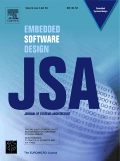
JOURNAL OF SYSTEMS ARCHITECTURE
Exploring Cutting-edge Research in ArchitectureJOURNAL OF SYSTEMS ARCHITECTURE is a prestigious academic journal published by ELSEVIER, based in the Netherlands, that has established itself as a leading platform for research in the fields of Hardware and Architecture and Software. With an impressive impact factor and ranked in the Q1 category for both computer science sectors, this journal is recognized for its high-quality contributions, evidenced by its Scopus ranking of #32 in Hardware and Architecture and #74 in Software, placing it in the top percentiles of its field. The journal spans a wide range of topics central to systems architecture, focusing on innovative research that advances the understanding of computer systems and promotes future developments. Researchers, professionals, and students alike will find invaluable insights and emerging trends that address the challenges and opportunities within the rapidly evolving field of systems design and architecture. Spanning from 1996 to 2024, the JOURNAL OF SYSTEMS ARCHITECTURE continues to be a vital resource for those seeking to stay at the forefront of technology and research.

Journal of Cloud Computing-Advances Systems and Applications
Advancing Knowledge in Cloud ComputingThe Journal of Cloud Computing - Advances Systems and Applications, published by Springer, serves as a premier platform for disseminating cutting-edge research in the fields of cloud computing, computer networks, and software technologies. With an impressive impact factor and ranked in the top quartile for Computer Networks and Communications and Software categories in 2023, this open access journal has gained significant recognition within the academic community since its establishment in 2012. The journal not only provides valuable insights into innovative applications and advancements in cloud technologies but also supports collaboration among scholars, practitioners, and industry leaders. Operating from the vibrant hub of New York City, it boasts a robust international readership, ensuring that the latest findings reach a diverse audience. Authors and researchers are encouraged to engage with this vital resource, which is dedicated to exploring the transformative potential of cloud computing across multiple disciplines.
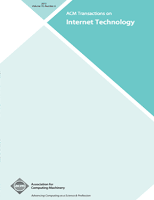
ACM Transactions on Internet Technology
Advancing the Frontiers of Internet TechnologyACM Transactions on Internet Technology, ISSN 1533-5399 (E-ISSN 1557-6051), is a premier journal published by the Association for Computing Machinery (ACM) that has made significant contributions to the field of computer science, particularly in the areas of computer networks and communications. Established in 2001, this journal has swiftly ascended to a prestigious Q1 ranking in its category as of 2023, demonstrating its influence within the scientific community, evidenced by its high Scopus rank of #41 out of 395 journals and a remarkable 89th percentile ranking. The journal serves as a vital platform for researchers, professionals, and students, offering a spectrum of scholarly articles that explore advancements in Internet technology, design, applications, and performance. With a commitment to high-quality research, ACM Transactions on Internet Technology is dedicated to fostering knowledge exchange and innovative problem-solving in an ever-evolving technological landscape. Readers can look forward to insights into both theoretical frameworks and practical implementations, making it an essential resource for cutting-edge research and developments in the digital frontier.

JOURNAL OF SUPERCOMPUTING
Transforming Ideas into Supercomputing SolutionsJOURNAL OF SUPERCOMPUTING is a premier academic journal published by SPRINGER, situated in the Netherlands, that has made significant contributions to the fields of computer science, particularly in hardware and architecture, information systems, software, and theoretical computer science. With a robust publication history spanning from 1987 to 2024, this journal has cultivated a strong reputation, evidenced by its Category Quartiles ranking in the Q2 category across multiple relevant domains in 2023. The journal's Scopus rankings further underscore its influence, boasting a 78th percentile in mathematics and theoretical computer science, revealing the high quality of research disseminated within its pages. As vital discourse unfolds in the realm of supercomputing—where innovative techniques and technologies rapidly evolve—this journal serves as a crucial platform for researchers, professionals, and students to explore cutting-edge studies and build upon the foundations of knowledge in this dynamic field.
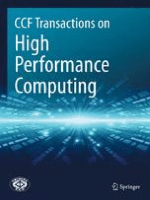
CCF Transactions on High Performance Computing
Advancing the Frontiers of High-Performance ComputingCCF Transactions on High Performance Computing, published by SPRINGERNATURE, is an esteemed academic journal dedicated to advancing research in the field of high-performance computing. With an ISSN of 2524-4922 and E-ISSN of 2524-4930, this journal provides a platform for disseminating innovative findings, methodologies, and technologies that shape computational practices within various domains. Operating from Germany, it serves a global audience, reinforcing its impact through an impressive categorization in the Q3 quartile across multiple fields, including Computer Science Applications and Information Systems. The journal, which covers research from 2019 to 2024, plays a crucial role in bridging gaps between theory and practical implementation in hardware architecture and software systems. Although it is not an open-access journal, its contributions are invaluable for researchers, professionals, and students invested in the continuous evolution of high-performance computing. With Scopus rankings that highlight its relevance and influence in the academic community, CCF Transactions on High Performance Computing remains a key resource for the latest developments in this dynamic and rapidly evolving discipline.
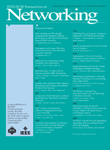
IEEE-ACM TRANSACTIONS ON NETWORKING
Advancing Knowledge in Networking TechnologiesIEEE-ACM Transactions on Networking, published by the esteemed IEEE-Institute of Electrical and Electronics Engineers Inc., stands as a pivotal source of research within the realms of Computer Networks and Communications, Computer Science Applications, Electrical and Electronic Engineering, and Software. With an impressive impact factor and recognized as a Q1 journal across multiple categories in 2023, it ranks among the top journals in its field, reflecting its influential scholarship and rigorous peer-review process. The journal has been continuously published since 1993 and features cutting-edge research that addresses the complexities and advancements in networking technologies. While it does not offer open access, its research is accessible through various academic platforms, ensuring that scholars, practitioners, and students can engage with and benefit from its rich content. The Scopus ranking further highlights its significance, with notable percentiles in engineering and computer science disciplines. This journal is essential for anyone seeking to stay ahead in the rapidly evolving area of networking.